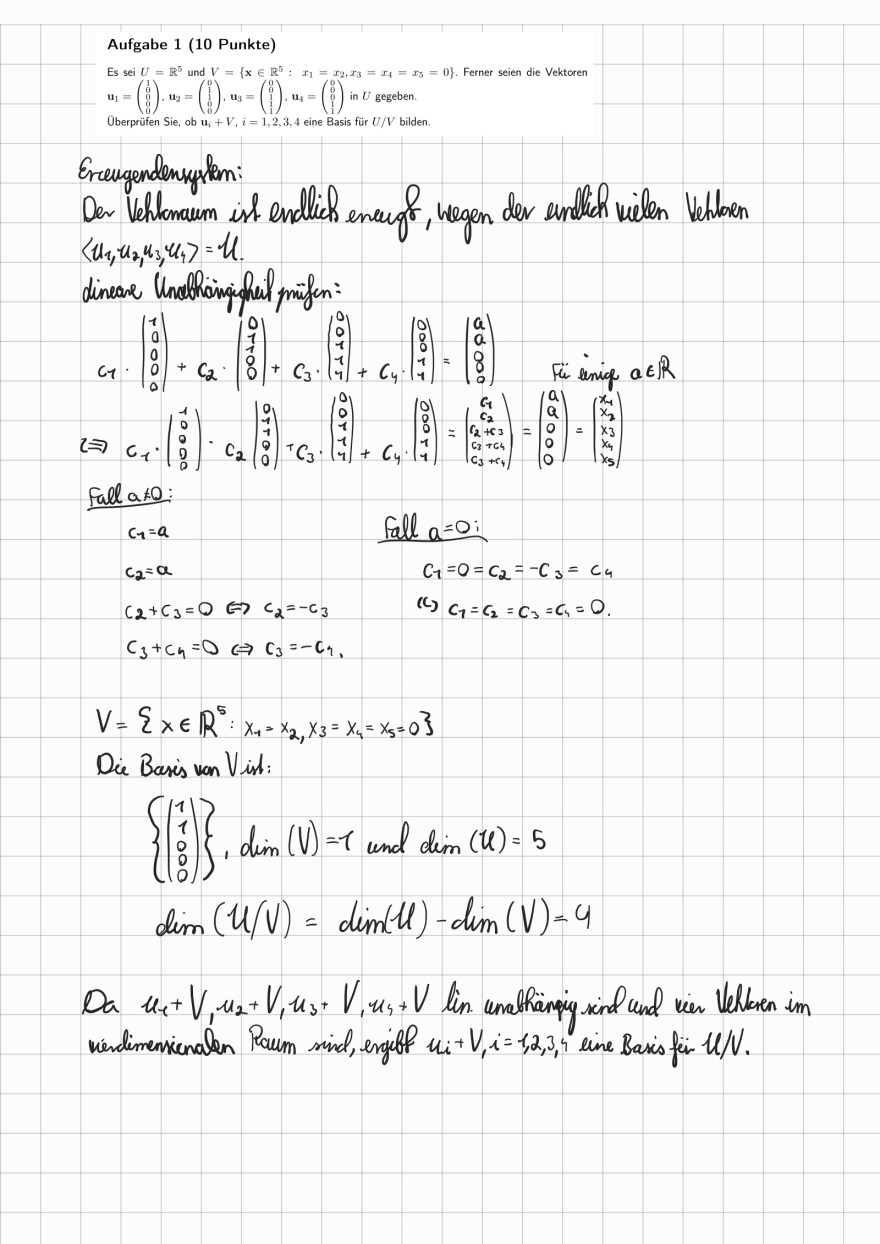Aufgabe:
Es sei \( U=\mathbb{R}^{5} \) und \( V=\left\{\mathbf{x} \in \mathbb{R}^{5}: x_{1}=x_{2}, x_{3}=x_{4}=x_{5}=0\right\} \). Ferner seien die Vektoren \( \mathbf{u}_{1}=\left(\begin{array}{l}1 \\ 0 \\ 0 \\ 0 \\ 0\end{array}\right), \mathbf{u}_{2}=\left(\begin{array}{l}0 \\ 1 \\ 1 \\ 0 \\ 0\end{array}\right), \mathbf{u}_{3}=\left(\begin{array}{l}0 \\ 0 \\ 1 \\ 1 \\ 1\end{array}\right), \mathbf{u}_{4}=\left(\begin{array}{l}0 \\ 0 \\ 0 \\ 1 \\ 1\end{array}\right) \) in \( U \) gegeben.
Überprüfen Sie, ob \( \mathbf{u}_{i}+V, i=1,2,3,4 \) eine Basis für \( U / V \) bilden.
Problem/Ansatz:
Unten hab ich mein Lösungsweg, kann da jemand rüberschauen?
Text erkannt:
Aufgabe 1 (10 Punkte)
\( \begin{array}{l} \text { Es sei } U=\mathbb{R}^{5} \text { und } V=\left\{\mathbf{x} \in \mathbb{R}^{5}: x_{1}=x_{2}, x_{3}=x_{4}=x_{5}=0\right\} \text {. Ferner seien die Vektoren } \\ \mathbf{u}_{1}=\left(\begin{array}{l} 1 \\ 0 \\ 0 \\ 0 \end{array}\right), \mathbf{u}_{2}=\left(\begin{array}{l} 0 \\ 1 \\ 1 \\ 0 \\ 0 \end{array}\right), \mathbf{u}_{3}=\left(\begin{array}{l} 0 \\ 0 \\ 1 \\ 1 \end{array}\right), \mathbf{u}_{4}=\left(\begin{array}{l} 0 \\ 0 \\ 1 \\ 1 \end{array}\right) \text { in } U \text { gegeben. } \\ \text { Oberpruf́en Sie, ob } \mathbf{u}_{i}+V, i=1,2,3,4 \text { eine Basis für } U / V \text { bilden. } \end{array} \)
Ereeugendensyslem:
Der Vehknaum ist encllich eneugf, wegen der endlich villen Vehtoen
\( \left\langle u_{1}, u_{2}, u_{3}, u_{4}\right\rangle=U \text {. } \)
dineare Unalbhaingigheit pinfen:
\( \begin{array}{l} c_{1} \cdot\left(\begin{array}{l} 1 \\ 0 \\ 0 \\ 0 \\ 0 \end{array}\right)+c_{2} \cdot\left(\begin{array}{l} 0 \\ 1 \\ 0 \\ 0 \end{array}\right)+c_{3} \cdot\left(\begin{array}{l} 0 \\ 0 \\ 1 \\ 1 \end{array}\right)+c_{4} \cdot\left(\begin{array}{l} 0 \\ 0 \\ 1 \\ 1 \end{array}\right)=\left(\begin{array}{l} a \\ a \\ 0 \\ 0 \end{array}\right) \quad \text { Frie eimice } a \in \mathbb{R} \\ \Leftrightarrow c_{1} \cdot\left(\begin{array}{l} 1 \\ 0 \\ 0 \\ 0 \end{array}\right) \cdot c_{2}\left(\begin{array}{l} 0 \\ 1 \\ 1 \\ 0 \end{array}\right)+c_{3} \cdot\left(\begin{array}{l} 0 \\ 0 \\ 1 \\ 1 \\ 1 \end{array}\right)+c_{4} \cdot\left(\begin{array}{c} 0 \\ 0 \\ \vdots \\ 1 \end{array}\right)=\left(\begin{array}{c} c_{1} \\ c_{2} \\ c_{2}+c_{2} \\ c_{3}+c_{3}+c_{4} \end{array}\right)=\left(\begin{array}{l} a \\ a \\ 0 \\ 0 \\ 0 \end{array}\right)=\left(\begin{array}{l} x_{1} \\ x_{2} \\ x_{3} \\ x_{3} \\ x_{3} \end{array}\right) \\ \end{array} \)
fall \( a \neq 0 \) :
\( c_{1}=a \)
fall \( a=0 \) :
\( c_{2}=a \)
\( c_{1}=0=c_{2}=-c_{3}=c_{4} \)
\( c_{2}+c_{3}=0 \Leftrightarrow c_{2}=-c_{3} \)
(c) \( c_{1}=c_{2}=c_{3}=c_{1}=0 \).
\( \begin{aligned} & c_{3}+c_{4}=0 \Leftrightarrow c_{3}=-c_{4} . \\ V= & \left\{x \in \mathbb{R}^{5}: x_{4}=x_{2}, x_{3}=x_{4}=x_{5}=0\right\} \end{aligned} \)
Die Basis von Vist:
\( \begin{array}{l} \left.\left\{\begin{array}{l} 1 \\ 1 \\ 0 \\ 0 \end{array}\right)\right\}, \operatorname{dim}(V)=1 \text { und } \operatorname{dim}(U)=5 \\ \operatorname{dim}(U / V)=\operatorname{dim}(U)-\operatorname{dim}(V)=4 \end{array} \)
\( D a u_{1}+V, u_{2}+V, u_{3}+V, u_{3}+V \) lin. unaltiaingig ssind und vier Velloren im mendimemienalen Raum sind, engibf \( u_{i}+V, i=1,2,3,4 \) eine Baris fii \( U / V \).